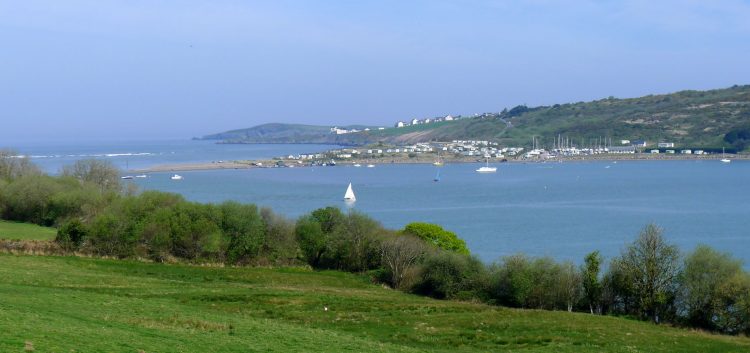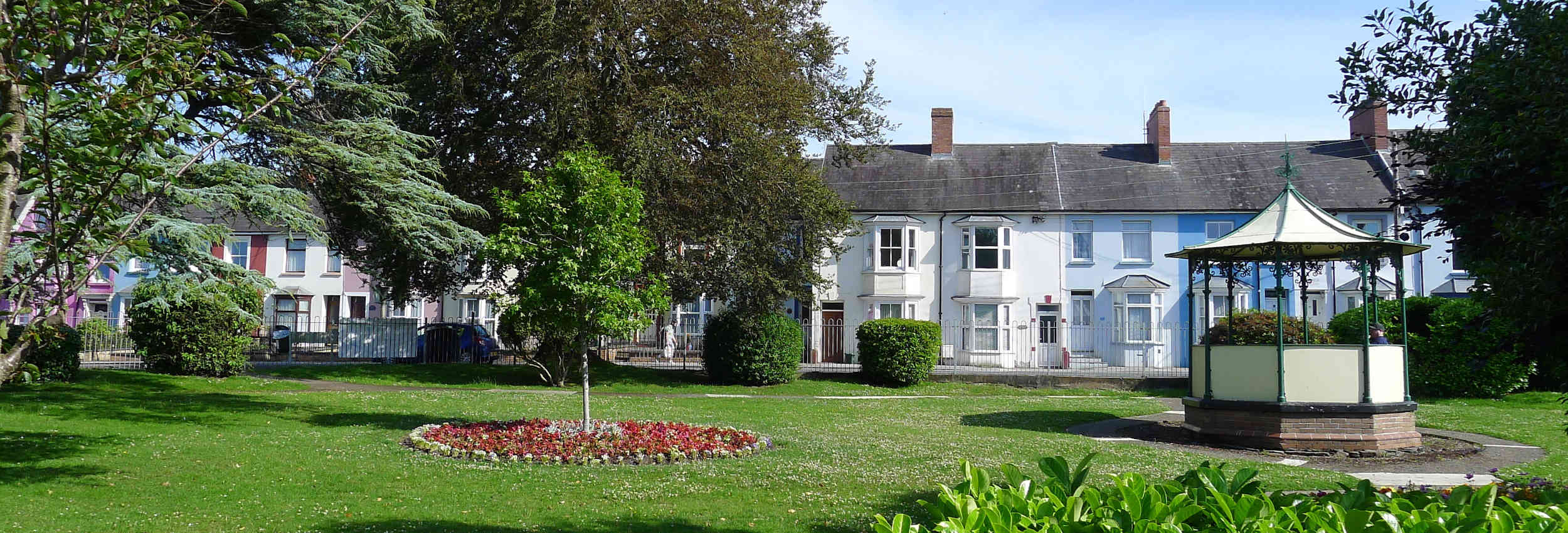Geological landscape
The hills, valleys and coast of the Cardigan area display a wide range of physical features that reveal its complex geological history.

The folding led to the injection of fluids through the rocks and the paths which these fluids followed are now infilled locally by a network of white quartz veins.

Photo 4 – Poppit Sands: quartz veins cutting through Ordovician cleaved mudstones. The quartz veins were formed when the deeply buried rock was permeated by and superheated fluids. On release of pressure quartz crystallised out of the fluids in tension cracks. |
 Photo 5 – Fossils are rare in the local rocks. Graptolites are used to date the rocks but these are poorly preserved. Animals that crawled along the ancient sea bed locally left tracks which are termed “trace fossils”. This example comes from Ordovician mudstones exposed on the beach north of Llangranog Photo 5 – Fossils are rare in the local rocks. Graptolites are used to date the rocks but these are poorly preserved. Animals that crawled along the ancient sea bed locally left tracks which are termed “trace fossils”. This example comes from Ordovician mudstones exposed on the beach north of Llangranog |
Very few fossils are found in the rocks because the sediments were deposited in deep water. The few graptolites (free swimming organisms that look like and are about the same size as flies legs) that have been found indicate that the rocks belong to the Ordovician System. In the 19th century the local slates were worked extensively in the gorge of the River Teifi between the Wildlife Centre (191449) and Cilgerran (206430). The slate was cut into slabs, rather than roofing slates, and used for making troughs, flooring and fireplaces. Some of the slate waste created by the workings was dumped into the river changing its flow pattern and leading to enhanced flooding upstream and silting downstream.
No evidence of rocks younger than the Ordovician period is found in the Cardigan area, though much of Cardigan Bay is infilled with a thick succession of Jurassic rocks similar to those in southern England. These rocks reach near to the seabed within 5km northwest of Cemaes Head (131502).
The Ice Age modified the landscape of the Cardigan area. The first ice sheet crossed the area a few hundred thousand years ago. Most of the evidence of this event was destroyed by the last ice sheet to cross the area which reached its maximum extent some 18 000 years ago. On land the southern limit of this ice sheet lay south of Cardigan, close to the crest of the Preseli Hills, but it flowed further south in St George’s Channel. Processes related to the ice sheet created a number of features:

Photo 6 – View looking east from Carn Bica on the crest of the Preseli hills. The crags on the right are Carn Menyn, the site of the stones used to construct Stonehenge. Foeldrygarn, a hill fort, is on the left in the distance. |

Photo 7 – Close up of Carn Menyn. Many of these jointed blocks of dolerite were transported to Salisbury Plain and used to construct Stonehenge. There is still a debate whether man or glacial processes transported the blocks. |
| Photo 8 (right) – River Teifi flowing through the gorge at Cilgerran with the castle overlooking the gorge side. The lower course of the River Teifi flows through some narrow gorge sections followed by wider, more open valleys.
Prior to the Ice Age the River Teifi flowed in a wide, meandering valley similar to that presently between Llechryd and Cenarth. At some time, when ice covered the region, the river cut across some of the meanders and incised a narrow gorge-like valley such as presently found between Llechryd and the Wildlife Centre. The old cut off meanders are now infilled but can be located (south of the Wildlife Centre) by careful examination of maps and the landscape. |
 |
 Photo 9 – Looking south from the Cardigan Wildlife park one can see the steep sides of the gorge in which the river flows |
 Photo 10 – Looking from the same viewpoint as Photo 9 but looking slightly to the west one can see the sloping sides of the older course of the river. This old river course is now infilled by up to 50m of sediment laid down before the last ice sheet covered the valley. |

Photo 11 – Looking northwest from Trwyn Carreg-ddu (Poppit Sands) at the section of coast where a raised beach is exposed. |
 Photo 12 – Raised beach along the coast shown in Photo 11. The beach is cut a metre or two above high water mark, and is overlain by boulder clay deposited about 18 000 years ago during the last ice age. |
| A raised beach a few metres above the high tide line west of Poppit Sands (147489). This beach was cut by wave action about 125 000 years ago and is covered by rounded wave-eroded boulders which in turn is covered by sticky boulder-rich clay laid down during the last ice age. | 
Photo 13 – Close up of the raised beach. The folded Ordovician mudstone are truncated by a smooth horizontal surface on which is lies a boulder-rich beach deposit. Boulder clay overlies the beach deposit. The raised beach was probably cut during a sea level high stand some 125 000 years ago. |

Photo 14 – Boulder clay deposited during the last ice age about 18 000 years ago infills the coastal valley at Mwnt. |

Photo 15 – Close up of boulder clay at beach level at Mwnt. The clay is full of clasts ranging in size from sand to boulder grade. Some of these clasts have been transported within the ice sheet from the floor of the Irish Sea, North Wales and Southern Scotland. These glacial erratics are common on the beaches of the area and include a range of igneous and sedimentary rocks. |
This clay, deposited some 18 000 to 15000 years ago contains many boulders and pebbles from North Wales and south west Scotland (glacial erratics) that were transported south in the ice.
 Photo 16 – Erratic boulder of quartzite – probably from North Wales – resting on mudstones, at Poppit Photo 16 – Erratic boulder of quartzite – probably from North Wales – resting on mudstones, at Poppit |

Photo 17 – Pebble of Jurassic ironstone- probably from the floor of Cardigan Bay- picked from the beach at patch. |

Photo 18 – Sand pit west of Penparc, part of a sand unit that extends southwards to also include Banc-y-Waren. This sand body and that at Monington were laid down by deltas in an extensive lake during the early stages of the retreat of the last ice sheet about 18 to 15 000 years ago late. |
The extensive sand bodies forming Banc-y-Warren (204475) and the quarries to the north.These were laid down by a river flowing out of the last ice sheet as it melted. The present location of these deposits highlights how the ice sheet must have been hundreds of metres thick and dominated the whole landscape. Similar deposits are found at Trefigin(132434) |
| Local gorge-like valleys (Cwm Degwel, St Dogmaels-162453) and channels that were incised by melt water flowing beneath the ice sheet.
Once the ice sheet retreated the barren landscape was subject to strong winds and sand was blown high onto Towyn Warren (168 490) at Gwbert, the south of the Cardigan Golf Club. |

Photo 19 – View looking north from above the Webley Hotel at the Pen yr Ergyd spit that occupies the mouth of the Teifi estuary. The spit is fed by the gravel on the foreshore on its seaward side. Waved blowing from the north move the gravel from the foreshore onto the spit with is slowly extending southwards and forcing the river channel towards the western (near) shore. A sailing vessel is stranded on the outer beach, having missed the river channel on its journey to sea. |
The landscape in the estuary continues to change. The spit at Pen yr Ergyd (160486) is expanding causing erosion on the south western bank of the river, and the dunes in the western part of Poppit Sands have expanded greatly in the past two decades.





